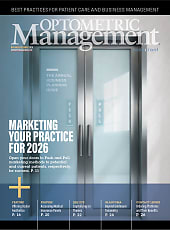Fluid reservoir debris, commonly known as midday fogging, is a frequent observation among scleral lens (SL) wearers.¹ It has been reported in up to 46% of SL wearers and can negatively impact the quality of vision.2,3 Midday fogging can be distinguished from front-surface lens fogging with biomicroscopy, anterior segment ocular coherence tomography (AS-OCT), or Scheimpflug imaging.¹
Several strategies can be used to manage midday fogging. Periodic SL removal and reapplication can provide temporary relief. Modifying the lens fit, such as optimizing landing zone alignment, reducing reservoir thickness,2,4 or selecting a different lens material,5 may reduce debris accumulation. Adjustments to lens care, including the use of hydrogen peroxide-based systems or more viscous filling solutions,6 can also be beneficial. Additionally, applying a lens surface treatment7 and managing underlying ocular surface disease, such as allergies or dry eye disease,8 may help mitigate midday fogging symptoms.
A recent study evaluated the effect of using a high-viscosity sodium hyaluronate solution in the fluid reservoir on post-lens fluid turbidity and SL settling.9 SLs were fitted on 40 eyes of 22 individuals with keratoconus. In each participant, SLs applied to the right eye were filled with a preservative-free sodium hyaluronate filling solution, while those applied to the left eye were filled with preservative-free saline. High- and low-contrast visual acuities (VAs) were measured at 0, 4, and 8 hours after SL application. Scheimpflug tomography was used to measure and calculate the optical density of the post-lens fluid, while AS-OCT was utilized for image grading and to measure lens settling and central corneal clearance.
High-contrast VA did not change significantly in either group over time. In the right eyes (hyaluronate solution), low-contrast VA remained stable during the 8 hours of SL wear, whereas in the left eyes (saline), low-contrast VA decreased at the 4- and 8-hour measurements. Regardless of the type of filling solution, AS-OCT-based turbidity grading and optical density increased over time. No differences were observed between groups in the rate or magnitude of SL settling. This study concluded that high-viscosity sodium hyaluronate may help improve low-contrast visual performance in individuals who have keratoconus compared with saline, without adversely affecting post-lens fluid turbidity or impacting lens settling.
Dr. Barnett has received remuneration from ABB, AbbVie, Alcon, Azura, Bausch + Lomb, BCLA, Bruder, Cloudbreak Pharma, Dompé, Epion, OCuSOFT, ScienceBased Health, STAPLE Program, Tarsus, and Théa Pharma.
References
1. Barnett M, Courey C, Fadel D, et al. CLEAR - Scleral lenses. Cont Lens Anterior Eye. 2021 Apr;44(2):270-288. doi: 10.1016/j.clae.2021.02.001
2. Postnikoff CK, Pucker AD, Laurent J, Huisingh C, McGwin G, Nichols JJ. Identification of leukocytes associated with midday fogging in the post-lens tear film of scleral contact lens wearers. Invest Ophthalmol Vis Sci. 2019;60(1):226-233. doi: 10.1167/iovs.18-24664
3. Schornack MM, Fogt J, Harthan J, et al. Factors associated with patient-reported midday fogging in established scleral lens wearers. Contact Lens Anterior Eye. 2020;43(6):602-608. doi: 10.1016/j.clae.2020.03.005
4. Skidmore KV, Walker MK, Marsack JD, Bergmanson JPG, Miller WL. A measure of tear inflow in habitual scleral lens wearers with and without midday fogging. Cont Lens Anterior Eye. 2019;42(1):36-42. doi: 10.1016/j.clae.2018.10.009
5. Walker MK, Bergmanson JP, Miller WL, Marsack JD, Johnson LA. Complications and fitting challenges associated with scleral contact lenses: A review. Cont Lens Anterior Eye.2016;39(2):88-96. doi: 10.1016/j.clae.2015.08.003
6. Fogt JS, Karres M, Barr JT. Changes in Symptoms of Midday fogging with a novel scleral contact lens filling solution. Optom Vis Sci.2020;97(9):690-696. doi: 10.1097/OPX.0000000000001559
7. Mickles CV, Harthan JS, Barnett M. Assessment of a novel lens surface treatment for scleral lens wearers with dry eye. Eye Contact Lens.2021;47(5):308-313. doi: 10.1097/ICL.0000000000000754
8. Fadel D. Scleral Lens issues and complications related to a non-optimal fitting relationship between the Lens and ocular surface. Eye Contact Lens. 2019;45(3):152-163. doi: 10.1097/ICL.0000000000000523
9. Vurgun EB, Ozkan G, Turhan SA, Toker AE. The effect of scleral lens reservoir solution on post-lens fluid turbidity and settling in patients with keratoconus. Eye Contact Lens. 2025 Oct 16. [Online ahead of print] doi: 10.1097/ICL.0000000000001231
This content was supported via unrestricted sponsorship



